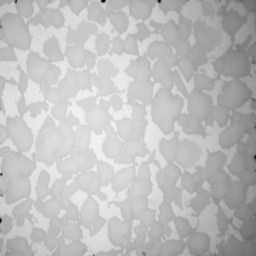GrayscaleFillHoles2d
Fills holes in particles of a two-dimensional grayscale image.
Access to parameter description
For an introduction:
Figure 1. Original image, gray hole fill result (hole level = image maximum)
Reference:
P. Soille, Morphological Image Analysis. Principles and Applications, Second Edition, Springer-Verlag, Berlin, p.208, 2003.
See also
Access to parameter description
For an introduction:
- section Mathematical Morphology
- section Geodesic Transformations
- The corresponding input image gray level on image borders,
- The "threshold filling value" inside the image.
 |
 |
Reference:
P. Soille, Morphological Image Analysis. Principles and Applications, Second Edition, Springer-Verlag, Berlin, p.208, 2003.
See also
Function Syntax
This function returns the outputImage output parameter.
// Function prototype.
std::shared_ptr< iolink::ImageView >
grayscaleFillHoles2d( std::shared_ptr< iolink::ImageView > inputImage,
double thresholdFillingValue,
GrayscaleFillHoles2d::Neighborhood neighborhood,
std::shared_ptr< iolink::ImageView > outputImage = NULL );
This function returns the outputImage output parameter.
// Function prototype.
grayscale_fill_holes_2d( input_image,
threshold_filling_value = 1,
neighborhood = GrayscaleFillHoles2d.Neighborhood.CONNECTIVITY_8,
output_image = None )
This function returns the outputImage output parameter.
// Function prototype.
public static IOLink.ImageView
GrayscaleFillHoles2d( IOLink.ImageView inputImage,
double thresholdFillingValue = 1,
GrayscaleFillHoles2d.Neighborhood neighborhood = ImageDev.GrayscaleFillHoles2d.Neighborhood.CONNECTIVITY_8,
IOLink.ImageView outputImage = null );
Class Syntax
Parameters
| Class Name | GrayscaleFillHoles2d |
|---|
| Parameter Name | Description | Type | Supported Values | Default Value | |||||
|---|---|---|---|---|---|---|---|---|---|
 |
inputImage |
The grayscale input image. | Image | Binary, Label or Grayscale | nullptr | ||||
 |
thresholdFillingValue |
The value filling the marker image inside (the gray level under which valleys are filled). The common usage is to set it at the image maximum intensity. | Float64 | Any value | 1 | ||||
 |
neighborhood |
The 2D neighborhood configuration for performing erosions of the numerical reconstruction.
|
Enumeration | CONNECTIVITY_8 | |||||
 |
outputImage |
The grayscale output image. Its dimensions and type are forced to the same values as the input. | Image | nullptr | |||||
Object Examples
std::shared_ptr< iolink::ImageView > polystyrene = ioformat::readImage( std::string( IMAGEDEVDATA_IMAGES_FOLDER ) + "polystyrene.tif" ); GrayscaleFillHoles2d grayscaleFillHoles2dAlgo; grayscaleFillHoles2dAlgo.setInputImage( polystyrene ); grayscaleFillHoles2dAlgo.setThresholdFillingValue( 0.0 ); grayscaleFillHoles2dAlgo.setNeighborhood( GrayscaleFillHoles2d::Neighborhood::CONNECTIVITY_8 ); grayscaleFillHoles2dAlgo.execute(); std::cout << "outputImage:" << grayscaleFillHoles2dAlgo.outputImage()->toString();
polystyrene = ioformat.read_image(imagedev_data.get_image_path("polystyrene.tif"))
grayscale_fill_holes_2d_algo = imagedev.GrayscaleFillHoles2d()
grayscale_fill_holes_2d_algo.input_image = polystyrene
grayscale_fill_holes_2d_algo.threshold_filling_value = 0.0
grayscale_fill_holes_2d_algo.neighborhood = imagedev.GrayscaleFillHoles2d.CONNECTIVITY_8
grayscale_fill_holes_2d_algo.execute()
print( "output_image:", str( grayscale_fill_holes_2d_algo.output_image ) )
ImageView polystyrene = ViewIO.ReadImage( @"Data/images/polystyrene.tif" );
GrayscaleFillHoles2d grayscaleFillHoles2dAlgo = new GrayscaleFillHoles2d
{
inputImage = polystyrene,
thresholdFillingValue = 0.0,
neighborhood = GrayscaleFillHoles2d.Neighborhood.CONNECTIVITY_8
};
grayscaleFillHoles2dAlgo.Execute();
Console.WriteLine( "outputImage:" + grayscaleFillHoles2dAlgo.outputImage.ToString() );
Function Examples
std::shared_ptr< iolink::ImageView > polystyrene = ioformat::readImage( std::string( IMAGEDEVDATA_IMAGES_FOLDER ) + "polystyrene.tif" ); auto result = grayscaleFillHoles2d( polystyrene, 0.0, GrayscaleFillHoles2d::Neighborhood::CONNECTIVITY_8 ); std::cout << "outputImage:" << result->toString();
polystyrene = ioformat.read_image(imagedev_data.get_image_path("polystyrene.tif"))
result = imagedev.grayscale_fill_holes_2d( polystyrene, 0.0, imagedev.GrayscaleFillHoles2d.CONNECTIVITY_8 )
print( "output_image:", str( result ) )
ImageView polystyrene = ViewIO.ReadImage( @"Data/images/polystyrene.tif" ); IOLink.ImageView result = Processing.GrayscaleFillHoles2d( polystyrene, 0.0, GrayscaleFillHoles2d.Neighborhood.CONNECTIVITY_8 ); Console.WriteLine( "outputImage:" + result.ToString() );